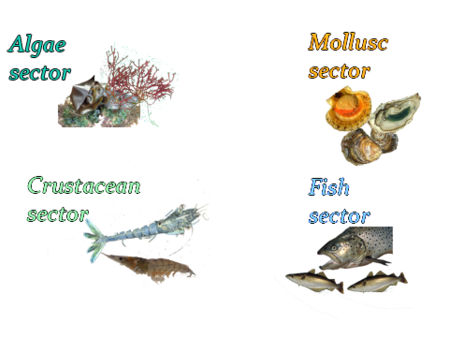Hatcheries, the case of the Pacific oyster
Aquaculture Sheet 13 March 2007
http://en.aquaculture.ifremer.fr/Info.-Card
This info-card was updated in 2011 but not yet translated. See the French version.
Characteristics
The culture and production of Pacific oyster Crassostrea gigas in France depends on natural collection from the wild for 70-80 % of spat and on hatchery production for between 20 and 30%, depending on years. Hatchery spat is different from wild-collected spat in the following ways :
- Production is spread over a longer period of the year
- Spat from hatcheries come ‘one by one’, i.e. individuals, not attached to a substrate or requiring physical separation work.
- Choice of size (T2 to T10 or more), and batches of homogeneous size.
- Choice of product: diploid or triploid oysters
- Future possibilities of genetic selection on criteria such as growth, resistance, shape and taste quality
The form of rearing used in the field is decided by the initial size.
Hatchery production must be accompanied by systematic prophylactic sanitary measures. While the level of natural settlement in the wild is dependant on the environment in the broadest sense (biological water quality, temperature during larval development, quantity and quality of nanoplankton), success in the hatchery is highly dependent on the microbiological quality of the rearing water. Bacterial development can be rapid and fatal for larvae and postlarvae due to the rearing techniques used : fine seawater filtration, organic matter input from phytoplankton and a relatively high temperature (25 °C).
Sex in Pacific oyster
The Pacific oyster is an alternate hermaphrodite. Oysters are generally male at their first sexual maturation (known as protandrous hermaphoditism), they then become female for their second or third reproductive season (according to site). However, there is a possibility that they can become male again over the course of their lives, depending on environmental conditions.
Stages of Larval development
Six to eight hours after fertilisation, shell-less trochophore larvae appear. Then, by about 24 hours, shells with two equal valves form to produce D-larvae.
These planktonic larvae measure 60 µm and have a velum, which they swim with and use to feed on small phytoplanktonic algae (3 to 4µm). These veliger larvae develop over 2 to 3 weeks depending on the rearing temperature and the quality and quantity of phytoplankton available: the hinge and hook appear around the eighth day when the larvae measure 130–160 µm on average. When the larvae reach 250–300 µm, a foot develops, as does a light-sensitive organ that forms a black spot. These larvae are then known as eyed larvae or pediveligers.
|
|
|
|
Eyed larvae develop “positive geotropism”, which induces them to search for a substrate on the bottom on which they can settle. The velum disappears and the larvae crawl over the substrate using their feet, which later disappear as they settle and fix themselves to the substrate. Metamorphosis takes place and young oysters are produced (spat stage).
Stages of production
Spawning and larval rearing
Spawning is generally induced by thermal shock. As soon as the first signs of gamete emission are seen, males are isolated in one tank and females in another to avoid risks of polyspermy. Gametes can also be collected by opening the oysters and stripping the gonads. Sperm is then added to a suspension of oocytes mixed by air bubbling. About 24 hours after fertilisation, D-larvae are collected by sieving on a mesh of 45 µm, numbers are estimated and the larvae are put in cylindroconical rearing tanks of 2-10 m3 at an initial density of 5000 to 10 000 larvae per litre. Rearing temperature is 22 to 28 °C. Food is made up of small phytoplanktonic algae (Isochrysis sp., Chaetoceros sp.) grown in the hatchery. Every two days the water in the tanks is changed and the larvae are collected on sieves of increasing mesh size (80 µm, 100 µm, 125 µm, 200 µm, etc.) in such a way as to select only the best growing larvae.
Fixation and growing on
In the third week or so, when pediveliger larvae appear, they are placed in sieve-bottomed trays containing ground oyster shell cultch. This cultch is sufficiently fine (<300 µm) that only a single larva may settle per fragment. The settlement stage takes about a week. Young spat are then put in a micronursery in trays with mesh of 500 µm and continuous water circulation. Temperature is progressively lowered to reach the exterior temperature at the end of the micronursery stage. Food is gradually replaced by the diatom Skeletonema costatum. The micronursery stage lasts from 3 weeks to one month, by which time the spat have reached a size above 1 mm. The spat are then put in an outside nursery supplied with unfiltered seawater and Skeletonema costatum. They continue to be reared in mesh-bottomed tubs through which the seawater circulates from the bottom to the top. The young oysters are regularly sieved to make up batches homogenous in size. The nursery phase lasts 2 to 3 months to obtain spat that are generally sold at size T6, which is to say spat that can be collected on a mesh of 6 mm.
|
|
|
|
Photo credits: Ifremer Argenton (R. Ben Kheder)/ Ifremer Bouin (J. L. Martin)/ Ifremer La Tremblade

